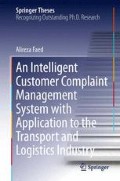Abstract
In this chapter, we carry out the modelling of dissatisfaction and satisfaction through the five steps of customer screening, data reduction, principal component analysis, data envelopment analysis, achieving potential improvement and providing recommendations in order to address the issues at the Fremantle port. We also re-validate our hypotheses for the major variables using a complete methodology. This process will help us to group our customers into clusters and we map the issues and the impact factors to these clusters. This in turn helps us to identify and prioritise the significant issues that should be addressed first in order to improve customer satisfaction within the shortest time with maximum results. This concept can be proven by the processes of analytical hierarchy and sensitivity analysis which provide mapping between customer type and satisfaction level.
Access this chapter
Tax calculation will be finalised at checkout
Purchases are for personal use only
References
Charnes, A., Cooper, W. W., & Rhodes, E. (1978). Measuring the efficiency of decision making units. European Journal of Operational Research, 2, 429–444.
Luo, X., & Homburg, C. (2007). Neglected outcomes of customer satisfaction. Journal of Marketing, 71, 133–149.
Andersen, P., & Petersen, N. C. (1993) A procedure for ranking efficient units in data envelopment analysis. Management science,1261–1264.
Faed, A., Hussain, O. K., Faed, M., Saberi, Z. (2012) Linear modelling and optimization to evaluate customer satisfaction and loyalty. Presented at the the 9th IEEE International Conference on e-Business Engineering.
Saaty, T.L., & Vargas, L.G. (2001) The seven pillars of the analytic hierarchy process. Models, Methods, Concepts & Applications of the Analytic Hierarchy Process, 27–46.
Vaidya, O. S., & Kumar, S. (2006). Analytic hierarchy process: an overview of applications. European Journal of Operational Research, 169, 1–29.
Zhu, L., Aurum, A., Gorton, I., & Jeffery, R. (2005). Tradeoff and sensitivity analysis in software architecture evaluation using analytic hierarchy process. Software Quality Journal, 13, 357–375.
Shafiq N., & Khamidi, M. F. (2009) Performing sensitivity analysis of pipeline risk failure using analytical hierarchy process.
Udo, G. G. (2000). Using analytic hierarchy process to analyze the information technology outsourcing decision. Industrial Management & Data Systems, 100, 421–429.
Bayraktar, E., Tatoglu, E., Turkyilmaz, A., Delen, D., & Zaim, S. (2012). Measuring the efficiency of customer satisfaction and loyalty for mobile phone brands with DEA. Expert Systems with Applications, 39, 99–106.
Cummins, J. D., & Xie, X. (2008). Mergers and acquisitions in the US property-liability insurance industry: Productivity and efficiency effects. Journal of Banking & Finance, 32, 30–55.
Öztaysi, B., Kaya, T., & Kahraman, C. (2011). Performance comparison based on customer relationship management using analytic network process. Expert Systems with Applications, 38, 9788–9798.
Lin, M.-C., Wang, C.-C., Chen, M.-S., & Chang, C. A. (2008). Using AHP and TOPSIS approaches in customer-driven product design process. Computers in Industry, 59, 17–31.
Wu, M., & Cai, Y. (2011) Research of evaluation of customer relationship of logistics enterprise based on AHP, 1–4.
Author information
Authors and Affiliations
Corresponding author
Rights and permissions
Copyright information
© 2013 Springer Heidelberg
About this chapter
Cite this chapter
Faed, A. (2013). Improving Customer Satisfaction Through Customer Type Mapping and I-CRM Strategies. In: An Intelligent Customer Complaint Management System with Application to the Transport and Logistics Industry. Springer Theses. Springer, Heidelberg. https://doi.org/10.1007/978-3-319-00324-5_7
Download citation
DOI: https://doi.org/10.1007/978-3-319-00324-5_7
Published:
Publisher Name: Springer, Heidelberg
Print ISBN: 978-3-319-00323-8
Online ISBN: 978-3-319-00324-5
eBook Packages: EngineeringEngineering (R0)

